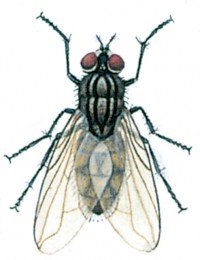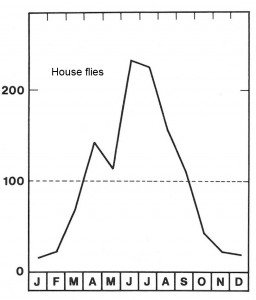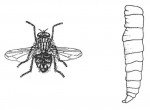Latin: Musca domestica.


Originates from warm climates, but is now widely spread everywhere. An adult house fly is 8-9 mm long, with a wingspan of 13 – 14 mm. Females seek fresh manure or rotting or fermenting plant material and lay eggs there. The eggs are laid in clumps with approximately 100 eggs and a female lays 10 clumps of eggs in a lifetime. The eggs hatch in 6-8 hours, and the pale limbless maggots seek out places where the temperature is 30 ° C. In pig or calf manure the larvae mature in 3 – 4 days. Then they are approximately 12 mm long and searching for cooler places where they can pupate. Inside the brown, immobile pupae transformation into adult flies happens over a few days and the entire development from egg to adult is completed in about 7 days. After one day the new flies are ready to mate and a day later the females begin to lay eggs. In the lab, you can keep the house flies for six months, but in the European stables their average life span is only a few days. Adult house flies love heat and prefer temperatures between 35 and 40 ° C when choosing habitats. In warm weather, with temperatures above 16 ° C flies can live outdoors where they can lay eggs on the dung heap or sit and bask on walls, and more. House flies are diurnal and they diligently examine their surroundings, especially when they are hungry. They are oriented primarily by sight. The sense of smell also plays a certain role and they can taste through the taste organs that sit on the feet and probosces.

Experiments with labelled flies have shown that they can easily fly several kilometres. The flies that hatch where there is plenty manure and feed will mostly stay put. On the other hand, it is a fact that neighbours can get their share of the fly production. Stables and middens, which are the source of houseflies, smell and may obviously annoy neighbours.
Although maggots can develop in kitchen waste, fly infestation in foods are almost always attributed to a stable or manure in the surroundings. In this case measures against flies are primarily aimed at testing whether anything can be done. In practice, however, it is difficult to keep agriculture free from flies. Therefore, one must often supplement the extermination with actions to keep the flies out of the food. Light traps are not effective against house flies. They can catch a few flies, but are worthless for actual extermination. Flies can be exterminated with poison, but not always with success because over time they become less sensitive to the toxins that are used.




